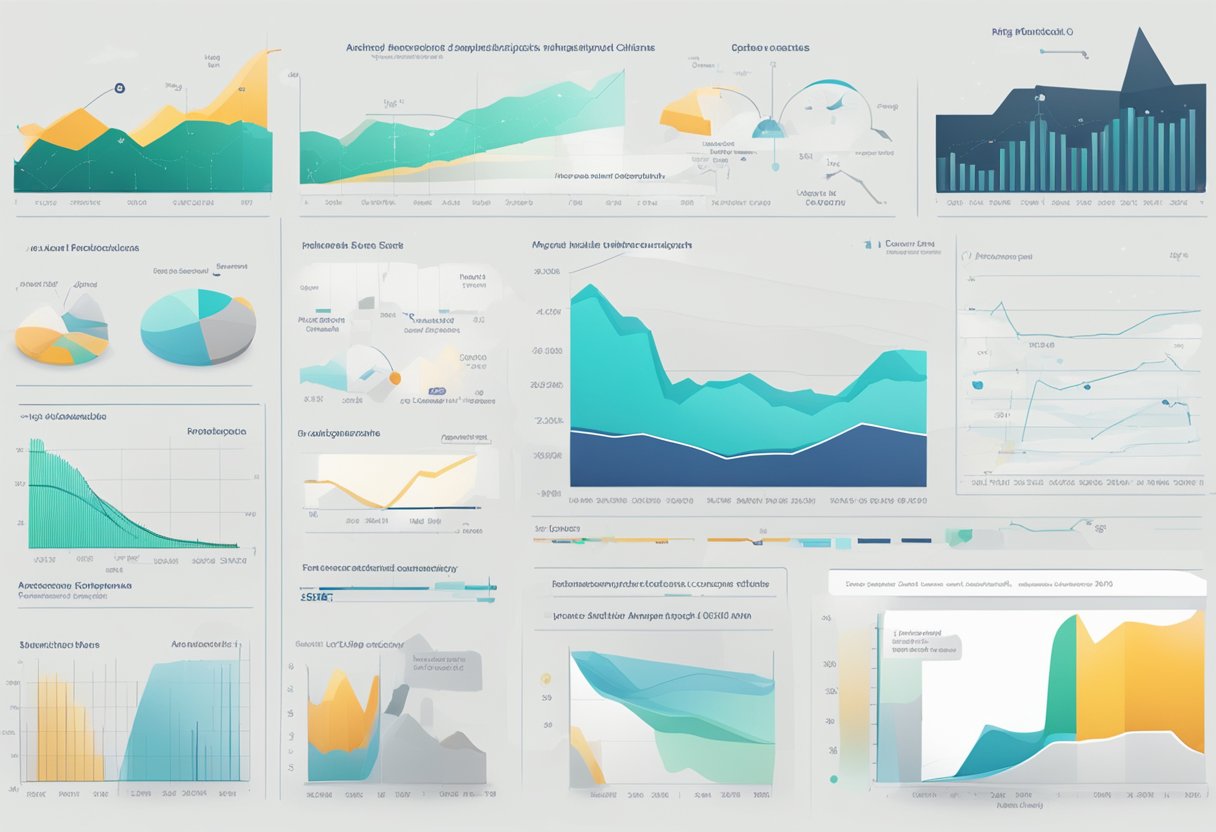Real-Time Analytics in Post-Trade Operations: Improving Efficiency and Reducing Risk
Discover how real-time analytics is improving efficiency and reducing risk in post-trade operations.

Real-time analytics has become a crucial element in post-trade operations in recent years. Advanced technologies and real-time data analysis have enabled capital markets firms to improve their efficiency and reduce operational costs. The post-trade process involves various activities such as trade confirmation, clearing, settlement, and reconciliation. Each activity generates significant data, which can be analyzed to identify inefficiencies and reduce operational risks.

The importance of real-time analytics in post-trade operations cannot be overstated. It allows firms to analyze and derive insights from a large amount of data generated during the post-trade process. Real-time analytics helps firms automate risk management and compliance across post-trade processes and create value. With the help of real-time analytics, firms can quickly identify and resolve issues, thereby improving their efficiency and reducing operational costs.
Key Takeaways
- Real-time analytics has become a crucial element in post-trade operations, enabling capital markets firms to improve their efficiency and reduce operational costs.
- Advanced technologies and real-time data analysis help firms automate risk management and compliance across post-trade processes and create value.
- Real-time analytics helps firms quickly identify and resolve issues, improving their efficiency and reducing operational costs.
The Importance of Real-Time Analytics in Post-Trade Operations

Real-time analytics is a discipline that applies logic and mathematics to data to provide insights for making better decisions quickly. In post-trade operations, real-time analytics can help firms generate insights to drive efficiencies, automate risk management and compliance, and create value.
Real-time analytics is crucial in post-trade operations because it enables firms to gain insights faster and improve reconciliations and controls. Providing real-time post-trade data is imperative in today's fast-paced trading environment. Ten years ago, access to post-trade data instantaneously would have been too complex, too expensive, or both. However, today's technology has made it possible to access real-time data and analytics, which can help firms make better trading decisions.
Real-time analytics can also help firms improve efficiency and security in post-trade operations. By using real-time analytics, firms can identify and address issues before they become problems. For example, real-time analytics can help firms detect fraudulent trades or suspicious activities in real, enabling them to take immediate action to prevent losses.
In innovation, real-time analytics can help firms gain a competitive advantage. Firms can use real-time analytics to identify new trading opportunities, develop new products and services, and improve customer experiences. Firms that embrace real-time analytics can stay ahead of the curve and remain competitive in today's fast-paced trading environment.
In conclusion, real-time analytics is essential in post-trade operations. It can help firms gain insights faster, improve efficiency and security, and drive innovation. Firms that embrace real-time analytics can stay ahead of the curve and remain competitive in today's fast-paced trading environment.
Understanding Post-Trade Processes

Post-trade processes are the steps that occur after a trade is executed. These processes include trade processing, settlement, and clearing. Understanding these processes is essential for anyone who wants to understand real-time analytics in post-trade operations.
Trade Processing
Trade processing is the first step in post-trade processing. It involves the validation and enrichment of trade data. DTradedata is checked for completeness, accuracy, and consistency. During this process, Any errors or discrepancies are identified and corrected. Once the data is validated, it is enriched with additional information, such as market and reference data.
Settlement
Settlement is transferring ownership of securities from the seller to the buyer. This process involves the exchange of cash and securities between the parties involved in the trade. Settlement can occur either on a gross or net basis. In a gross settlement, each trade is settled individually, while in a net settlement, multiple trades are netted off against each other.
Clearing
The clearing reconciles and confirms trades between the parties involved in the trade. During this process, the details of each trade are matched against the details of the counterparty's trade. Any discrepancies are identified and resolved. Once the trades are confirmed, they are sent to the settlement process.
Real-time analytics can improve the efficiency and accuracy of post-trade processes. For example, real-time analytics can be used to identify potential errors or discrepancies in trade data before they become a problem. They can also monitor settlement and clearing processes in real time, allowing faster resolution of any issues.
In conclusion, understanding post-trade processes is essential for anyone who wants to understand real-time analytics in post-trade operations. Trade processing, settlement, and clearing are the three main steps in post-trade processing, and real-time analytics can be used to improve the efficiency and accuracy of these processes.
Role of Technology in Post-Trade Operations

Post-trade operations are an integral part of the financial services industry, and technology is crucial in making these operations more efficient and effective. With the increasing complexity of financial transactions, there is a growing need for real-time analytics to ensure that trades are processed accurately and efficiently. In this section, we will explore the role of technology in post-trade operations, including automation, cloud-based solutions, and AI and machine learning.
Automation
Automation is one of the critical drivers of innovation in post-trade operations. It involves using technology to automate manual processes, reducing the risk of errors and increasing operational efficiency. Automation can help financial institutions to streamline their post-trade operations, enabling them to process trades more quickly and accurately. By automating routine tasks, such as trade confirmation and settlement, financial institutions can reduce the risk of errors and improve the speed and efficiency of their operations.
Cloud-Based Solutions
Cloud-based solutions are becoming increasingly popular in the financial services industry. They offer a range of benefits, including increased flexibility, scalability, and cost-effectiveness. Cloud-based solutions can help financial institutions process trades more quickly and efficiently, reducing the risk of errors. By leveraging cloud-based solutions, financial institutions can access real-time analytics and data, enabling them to make better-informed decisions about their post-trade operations.
AI and Machine Learning
AI and machine learning are transforming the financial services industry, and post-trade operations are no exception. AI and machine learning can help financial institutions process trades more quickly and accurately, reducing the risk of errors. By leveraging AI and machine learning, financial institutions can analyze large volumes of data honestly, enabling them to make better-informed decisions about their post-trade operations. AI and machine learning can also help financial institutions identify patterns and trends in their data, optimizing their post-trade operations and improving operational efficiency.
In conclusion, technology plays a critical role in post-trade operations. Automation, cloud-based solutions, and AI and machine learning are all essential drivers of innovation in this area. By leveraging these technologies, financial institutions can improve the speed and efficiency of their post-trade operations while reducing the risk of errors. As the financial services industry evolves, we will likely see further innovations in post-trade operations driven by the latest technological advances.
Impact of Real-Time Analytics on Various Asset Classes

Real-time analytics significantly impacts various asset classes, including securities, derivatives, and stocks. With real-time analytics, traders and investors can make better decisions quickly, leading to increased profits and reduced risk.
Real-time analytics can be instrumental in securities trading. For example, real-time data can help traders identify market trends and make informed decisions about when to buy or sell securities. Additionally, real-time analytics can help traders identify potential risks and take steps to mitigate them.
In the case of derivatives, real-time analytics can help traders identify opportunities to profit from market movements. For example, real-time data can help traders identify price discrepancies between different derivatives contracts and take advantage of them. Additionally, real-time analytics can help traders monitor the performance of their derivatives portfolios and adjust their positions as needed.
Real-time analytics can also have a significant impact on stock trading. With real-time data, traders can monitor the performance of individual stocks and identify trends that may affect their value. Additionally, real-time analytics can help traders identify potential risks associated with specific stocks and take steps to mitigate them.
Real-time analytics is a valuable tool for traders and investors across various asset classes. Real-time analytics can help traders make better decisions and achieve their investment goals by providing timely insights into market trends and risks.
Improving Efficiency and Reducing Operational Costs

Post-trade operations are complex and can be both expensive and labour-intensive. Creating, maintaining, and managing the IT infrastructure related to post-trade processing can overwhelm hedge fund and investment managers. The complexity of the regulatory environment also has a profound impact. However, with real-time analytics, post-trade operations can be streamlined, and efficiency can be improved while reducing operational costs.
Real-time analytics can help optimize post-trade operations by providing insights into the workflow, enabling firms to identify bottlenecks and take corrective action. Firms can monitor trade transactions, identify exceptions, and take disciplinary action with real-time analytics. This can help reduce the cost-per-trade and manage trading activities more efficiently.
Straight-through processing (STP) is a critical component of post-trade operations. Without manual intervention, it enables firms to automate the trade lifecycle, from trade capture to settlement. Real-time analytics can help optimize STP workflows by providing insights into the process, allowing the firms to identify bottlenecks and take corrective action. This can help improve real-time capabilities and enhance functions such as settlement allocations, asset servicing, management of real-time data, and back-end accounting.
Real-time analytics can also help improve scalability and operational efficiency. Firms can monitor trade transactions, identify exceptions, and take corrective action with real-time analytics. This can help reduce the cost-per-trade and manage trading activities more efficiently. Real-time analytics can also help firms adapt to innovations quickly, thereby staying ahead in the market.
In conclusion, real-time analytics can help improve efficiency and reduce operational costs in post-trade operations. By optimizing workflows, firms can reduce the cost-per-trade and manage trading activities more efficiently. Real-time analytics can also help firms adapt to innovations quickly and enhance functions such as settlement allocations, asset servicing, management of real-time data, and back-end accounting.
Risk Management and Governance in Post-Trade Operations

Post-trade operations involve complex processes that require effective risk management and governance to ensure compliance with regulatory requirements and mitigate operational and reputational risks. Real-time analytics can help firms identify and manage risks more effectively, enabling them to make informed decisions and take action quickly.
Effective risk management in post-trade operations requires a robust governance framework that includes policies, procedures, and controls to ensure compliance with regulatory requirements and mitigate risks. This framework should be designed to address critical risks such as settlement risk, credit risk, operational risk, and market risk.
Real-time analytics can help firms monitor and manage these risks more effectively by providing timely and accurate information on key indicators. For example, real-time analytics can monitor trade volumes, settlement failures, credit exposures, and market volatility, enabling firms to identify potential risks and take action quickly.
In addition to risk management, effective governance is critical in post-trade operations. Governance frameworks should include clear lines of responsibility, accountability, and policies and procedures to ensure compliance with regulatory requirements and industry best practices.
Real-time analytics can help firms monitor and enforce these policies and procedures more effectively, enabling them to quickly identify potential issues and take corrective action. For example, real-time analytics can monitor trade confirmations, trade matching, and settlement processes, ensuring compliance with regulatory requirements and industry best practices.
Overall, effective risk management and governance are critical in post-trade operations, and real-time analytics can play a crucial role in helping firms manage these risks more effectively. By providing timely and accurate information on key risk indicators and ensuring compliance with regulatory requirements and industry best practices, firms can reduce operational and reputational risks and improve their overall operating efficiency.
Adapting to the Changing Regulatory Landscape

To remain compliant, post-trade operations are heavily regulated, and firms must adapt to the changing regulatory landscape. New regulations are constantly being introduced, and firms must keep up with them to avoid penalties and reputational damage. Regulatory reporting is critical to post-trade operations, and firms must ensure that their reporting is accurate and timely.
One significant regulation that firms must comply with is the Central Securities Depositories Regulation (CSDR). The CSDR aims to increase the safety and efficiency of securities settlement in the EU and reduce settlement fails. Firms must comply with the CSDR's reporting requirements, including reporting settlement fails and penalties for such fails.
Firms must also keep up with other regulatory changes, such as changes to reporting requirements. For example, the European Securities and Markets Authority (ESMA) recently introduced new reporting requirements for securities financing transactions (SFTs). Firms must update their reporting systems to comply with these new requirements.
Firms must invest in real-time analytics to adapt to the changing regulatory landscape. Real-time analytics can help firms identify potential compliance issues before they occur, allowing them to take proactive measures to address them. Real-time analytics can also help firms monitor their reporting systems to ensure they are accurate and timely.
In conclusion, firms must adapt to the changing regulatory landscape to remain compliant and avoid penalties and reputational damage. Real-time analytics can help firms identify potential compliance issues and monitor their reporting systems to ensure they are accurate and timely. Compliance with regulations such as the CSDR and changes to reporting requirements such as SFTs is critical for firms operating in the post-trade industry.
The Future of Post-Trade Operations

Post-trade operations are undergoing a significant transformation due to the rise of digital innovation, including blockchain and distributed ledger technology. These new technologies are changing post-trade operations, leading to increased efficiency, reduced costs, and improved risk management.
Blockchain and Distributed Ledger Technology
Blockchain and distributed ledger technology are becoming increasingly prevalent in post-trade operations. These technologies offer a secure and transparent way to store and share data, essential for post-trade operations. Blockchain and distributed ledger technology can help to streamline post-trade processes, reduce costs, and improve risk management.
One of the key benefits of blockchain and distributed ledger technology is their ability to provide a single source of truth for all parties involved in a transaction. This can help reduce the risk of errors and fraud, with significant concern in post-trade operations. Additionally, blockchain and distributed ledger technology can help automate many post-trade processes, reducing the time and cost associated with these operations.
Impact of the Pandemic on Post-Trade Operations
The COVID-19 pandemic has had a significant impact on post-trade operations. The pandemic has highlighted the need for increased digitalization and automation in post-trade operations. Many firms have had to adapt to remote working environments, which has led to an increased focus on digitalization and automation.
The pandemic has also highlighted the need for increased resilience in post-trade operations. Many firms have had to deal with increased market volatility, leading to increased risk in post-trade operations. As a result, firms are focusing on improving their risk management processes and increasing their resilience to future shocks.
In conclusion, the future of post-trade operations will likely be shaped by digital innovation, including blockchain and distributed ledger technology. These technologies offer significant efficiency, cost reduction, and risk management benefits. Additionally, the COVID-19 pandemic has highlighted the need for increased digitalization and automation in post-trade operations and increased resilience to future shocks.


